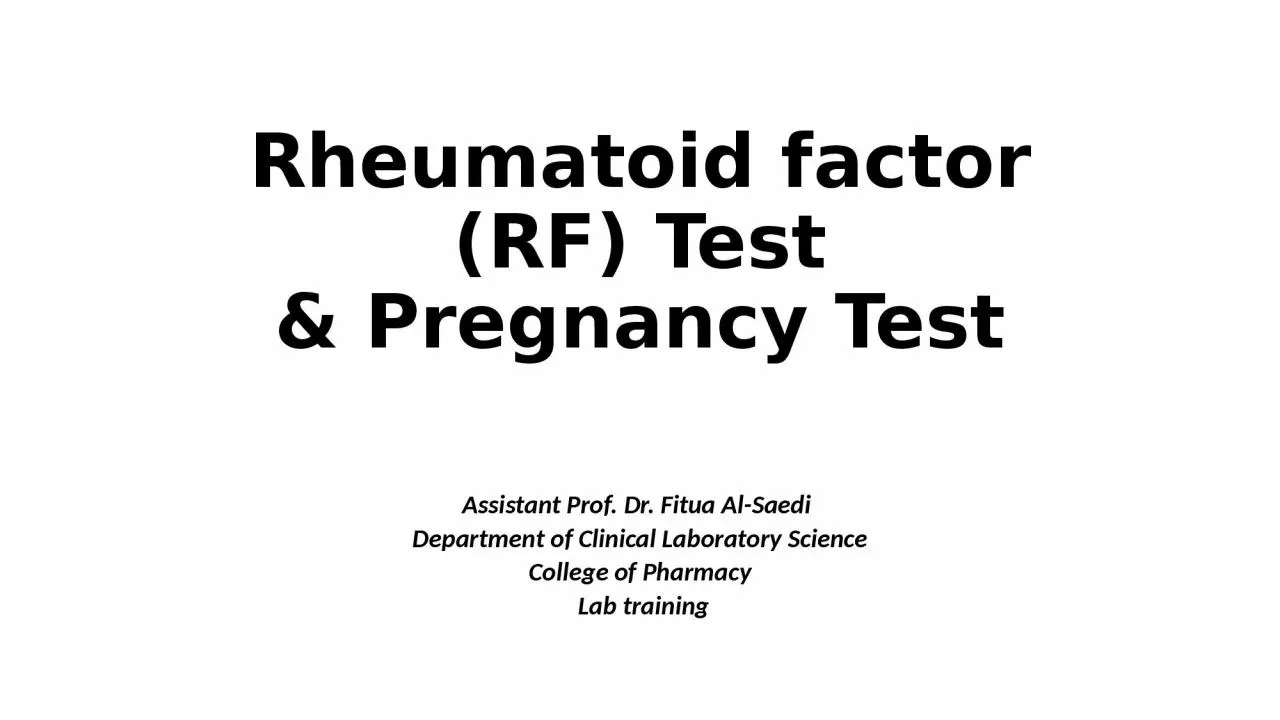

Test amp Pregnancy Test Assistant Prof Dr Fitua Al Saedi Department of Clinical Laboratory Science College of Pharmacy Lab training Rheumatoid factor RF test A rheumatoid factor RF test measures the amount of rheumatoid ID: 1014584
Download Presentation The PPT/PDF document "Rheumatoid factor (RF)" is the property of its rightful owner. Permission is granted to download and print the materials on this web site for personal, non-commercial use only, and to display it on your personal computer provided you do not modify the materials and that you retain all copyright notices contained in the materials. By downloading content from our website, you accept the terms of this agreement.
1. Rheumatoid factor (RF) Test& Pregnancy Test Assistant Prof. Dr. Fitua Al-SaediDepartment of Clinical Laboratory ScienceCollege of PharmacyLab training
2. Rheumatoid factor (RF) test?A rheumatoid factor (RF) test measures the amount of rheumatoid factors (RF) in the blood.Rheumatoid factors (RF) are antibodies directed against antigenic sites in theFc fragment of IgG antibodies.RF have been associated with three major immunoglobulin classes: IgM, IgG, and IgA. Of these IgM and IgG are the most common. The formation of immune complex in the joint space leads to the activation of complement and destructive inflammation, causing rheumatoid arthritis (RA).
3.
4. As indicated by its name, RF has particular application to diagnosis and monitoring of rheumatoid arthritis. Rheumatoid arthritis (RA) is a chronic inflammatory disease affecting primarily the joints and periarticular tissues. Rheumatoid factor is detected in 60-80% of cases of diagnosed rheumatoid arthritis.Rheumatoid factors may also be a sign of other autoimmune disorders, such as juvenile arthritis, certain infections, and some types of cancer.
5. Rheumatoid factor (RF) TestPRINCIPLE Latex particles (Polystyrene particles) coated with human gamma-globulin (IgG) are agglutinated when mixed with samples containing rheumatoid factors.
6. Qualitative methodAllow the reagents and samples to reach room temperature2. Place one drop of the positive control and 40µl of the patient serum into separate circles on the slide.3. Add one drop of RF latex reagent on each circle of sample to be tested and control.4. Use separate sticks to spread reaction mixture over entire area of the particular field.5. Rotate the slide slowly either by hand or by means of amechanical rotator for 2 minutes.6. Observe for agglutination after 2 minutes under under a suitable light source .
7. Interpretation of ResultsAgglutination of latex particles is considered a positive reaction, indicating the presence of rheumatoid factor at a significant and detectable level.Positive result: An agglutination of the latex particles suspension will occur within two minutes, indicating a RF level of more than 18 IU/ml.Negative result: No agglutination of the latex particles suspension within two minutes.
8. A-Using isotonic saline prepare serial dilutions of the test sample positive in the qualitative method 1:2, 1:4, 1:8, 1:16,1:32, and so on as follows :1-For each specimen to be tested, add 100 µL of 0.9% saline into test tubes numbered 1 to 5.2-Add 100 µL of specimen onto test tube 1.3-Mix the mixture. Avoid formation of bubbles.4-Transfer 100 µL of mixed sample from tube 1 to 2.5-Repeat this serial dilution procedure in tube 3 to 4, and then 5. Dispose 100 µL from test tube 5 after mixingTubes 1 to 5 now represent a dilution series as follows:Tube Number 1 2 3 4 5Dilution 1:2 1:4 1:8 1:16 1:32Semi-quantitative methodB-Perform the qualitative test procedure using each dilution as test specimen.
9. Semi-quantitative Test: The titer of the serum is the equal of thehighest dilution, which exhibits a positive reaction. An estimate of the RFconcentration in the specimen can be expressed in IU/ml by using thefollowing equation:IU/ml of specimen = IU/ml control x specimen titerInterpretation of Results
10. Positive RF Factor Is Seen In:Rheumatoid arthritis.Other autoimmune diseases like Systemic Lupus Erythematosus (SLE). Chronic viral infections.Tuberculosis.Chronic active hepatitis.Syphilis.Infectious mononucleosis.Leukemia.Biliary Cirrhosis.Renal disease
11. Limitations of RF test1-RF is not detected in all patients diagnosed with RA.2-RF may be detected in increased amounts in patients with infectious mononucleosis, sarcoidosis, systemic lupus erythematosus, TB or leprosy, and other conditions of acute or chronic immune response.3-The significance of a positive result should be interpreted with caution. Quantitative testing should be done to confirm diagnosis of RA.4- Highly haemolyzed and lipemic serum as well as plasma interfere with the test.
12. hCG Role in pregnancy:•Promotes the maintenance of the corpus luteum in the ovary during the beginning of pregnancy. This allows the corpus luteum to secrete the progesterone during the first trimester. Progesterone enriches the uterus with a thick lining of blood vessels and capillaries so that it can sustain the growing fetus.•Human chorionic gonadotropin also plays a role in cellular differentiation/proliferation.Pregnancy Test Determination of human Chorionic Gonadotropin(hCG ) SLIDE TEST
13. Detectable levels of Chorionic Gonadotropin (hCG) inurine start at 5 m IU/ml during the first week of gestation and rises to 100,000 mIU/ml at 2 to 3 months. Values decline from 10% to 15% of peak concentrations during 2nd and 3rd trimesters.
14. hCG-Latex Test PRINCIPLE hCG-Latex Test is a rapid slide agglutination procedure, developed for the direct detection of human Chorionic Gonadotropin (hCG) in urine. The assay is performed by testing a suspension of latex particles coated with monoclonal anti-hCG antibodies against unknown samples. The presence or absence of a visible agglutination, indicates the presence or absence of hCG in the sample tested
15. PROCEDURE 1. Bring reagents to room temperature.2. Place 100 µl of patient urine, one drop positiveand one drop negative controls into differentcircles of the slide.3. Add one drop of latex reagent directly to eachsample.4. Mix using the supplied sticks and spread themixture over the entire circle.5. Gently rock the slide. Agglutination may beobserved after two minutes. Direct light sourcemay help
16. Reading the resultPresence of agglutination within two minutes indicates positive reaction. Lack of agglutination within two minutes indicates negative reaction.
17. Thanks